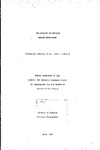The biology of British marine hemiuridae
| dc.contributor.author | Matthews, Brenda Fay | |
| dc.contributor.other | School of Biological and Marine Sciences | en_US |
| dc.date.accessioned | 2013-10-21T09:47:54Z | |
| dc.date.available | 2013-10-21T09:47:54Z | |
| dc.date.issued | 1982 | |
| dc.identifier | NOT AVAILABLE | en_US |
| dc.identifier.uri | http://hdl.handle.net/10026.1/2238 | |
| dc.description | Merged with duplicate record 10026.1/713 on 12.04.2017 by CS (TIS) | |
| dc.description.abstract |
The cystophorous hemiurid cercariae, Cercaria vaullegeardi and C. calliostomae, are recorded from the digestive gland of Gibbula umbilicalis and the gonad of calliostoma ziziphinum respectively. The encysted forms are described at ultrastructural level for the first time, and developmental stages redescribed. Specialisation of the anterior region and birth pore of the daughter sporocyst in c. vaullegeardi, and migration of the redia in C. calliostomae, ensure that in neither species does the cercaria, hindered by a bulky immotile cystophorous tail, itself have to migrate through blood vessels or tissues to the site of emergence from the molluscan host. The inoculative mechanism whereby hemiurid cercariae infect the copepod second intermediate host is described for the first time in C. vaullegeardi. Experimental infections of the harpacticoid copepod Tigriopus brevicornis are recorded, and the infection process is related to the ultrastructure of the cercaria and to the feeding mechanics of harpacticoids. The cystophorous tail of C. vaullegeardi is shown to be a device whose shape and construction ensure that the cercarial body is neither damaged by copepod mouthparts nor swallowed, but reaches the host haemocoel during the initial stages of feeding. The metacercaria grows rapidly within T. brevicornis, virtually filling the haemocoel 21 days after infection when maintained at l7°C. The development of the ecsoma from the eversible excretory vesicle is described. Post-larval Gobius paganellus have been experimentally infected by feeding 21 day-old metacercariae of C. vaullegeardi raised in T. brevicornis. Encapsulated metacercariae and adults are recorded from 12 species of fish examined for natural hemiuroid infections. function of the hemiurid ecsoma is discussed in relation both 7 out of 12 species of fish examined for natural hemiuroid infections. The Function of the hemiurid ecsoma is discussed in relation both to habitat of the adult within the host pyloric stomach, and to ultrastructural and autoradiographic studies of metacercarial and adult stages. | en_US |
| dc.language.iso | en | en_US |
| dc.publisher | University of Plymouth | en_US |
| dc.title | The biology of British marine hemiuridae | en_US |
| dc.type | Thesis | |
| dc.identifier.doi | http://dx.doi.org/10.24382/4780 | |
| dc.identifier.doi | http://dx.doi.org/10.24382/4780 |
Files in this item
This item appears in the following Collection(s)
-
01 Research Theses Main Collection
Research Theses Main


